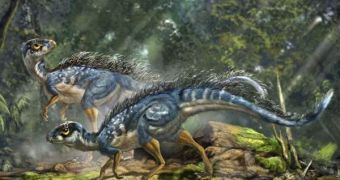A newly discovered dinosaur fossil seems to change a paradigm that has been in effect for several decades, and namely that only the saurischian dinosaur families had feathers or other feather-like formations on their bodies. The heterodontosaurs that was found in China was herbivorous, and was part of a completely different species of giant reptiles. The find could imply that feathers can be traced back to the very origin of the creatures, some 200 million years ago.
The saurischian family comprises the renowned tyrannosaurs and maniraptors species, and almost all of these beasts were carnivorous. Researchers have thus far thought that feathers were an attribute of these species alone, on account of the fact that they are believed to be the ancestors of modern birds. But the heterodontosaur (Tianyulong confuciusi) that has been found in the famous Chinese Liaoning Province fossil bed seems to share this trait as well, which means that other members of its family could have had feathers too.
The paper detailing the new find is published in the March 19th issue of the scientific journal Nature, and is a result of a collaboration between Shandong Tianyu Museum of Nature researcher Xioa-Ting Zheng, Chinese Academy of Geological Sciences' Institute of Geology expert Hai-Lu You, and Chinese Academy of Science's Institute of Vertebrate Paleontology and Paleoanthropology scientists Xing Xu and Zhi-Ming Dong.
The uncovered animal, which lived some 198 million years ago in the Cretaceous Period, had hollow structures resembling modern feathers on its neck, back and tail. The fossil hints at the fact that the creature was no larger than a fox and that it had a 2-inch-long tail, which was totally covered with these odd structures. Despite the fact that the heterodontosaurs proved to have had feathers on it, anthropologists are convinced that other species, such as the triceratops and the hadrosaurs, didn't have any.
“Finding something that looks like these feather-like features or proto-feathers in heterodontosaurs raises questions of whether the ancestral dinosaur was a fuzzy little animal. That's a big surprise and it turns out that raises new questions, which either means that many dinosaurs then, in fact, lost this fuzzy little coat, or another option is that the ancestral dinosaur wasn't covered in fuzz but what we see in this heterodontosaur might be a separate evolution of some sort of projecting epidermal filament,” Ohio University anatomist Lawrence Witmer says.

 14 DAY TRIAL //
14 DAY TRIAL //